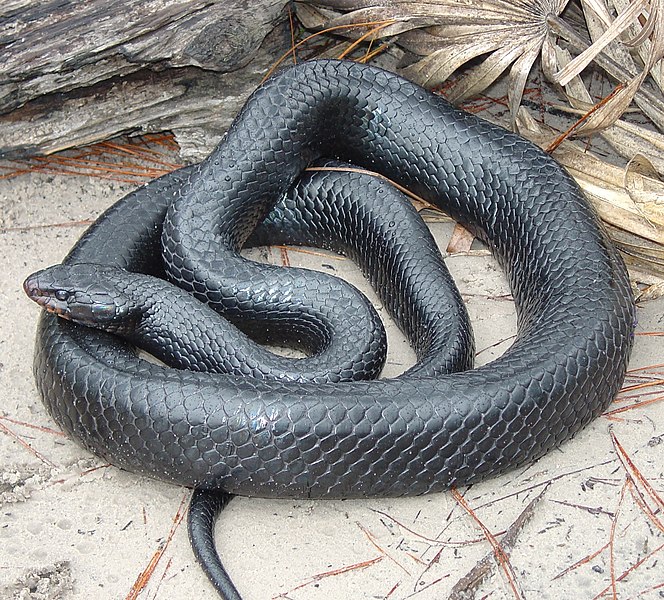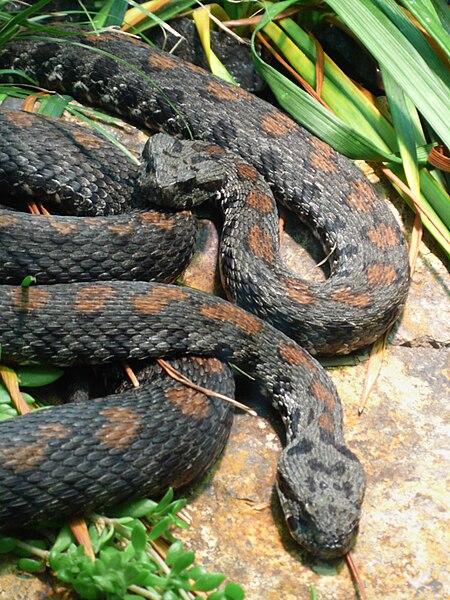 In 2010, I highlighted a study that documented steep declines in a number of snake species. Despite disturbing similarities to the “Disappearing Amphibian Crisis”, the snake situation seems not to have generated widespread concern. In my own career as a herpetologist, opportunities to become involved in snake conservation were also limited. Although I was fortunate enough to work in programs designed to bolster the populations of several species, including Green Anacondas, Indigo and Hognose Snakes, most such efforts were short-lived. I was pleased to learn, therefore, that a partnership of several major conservation organizations has made the plight of the world’s snakes a priority for the year 2013.
In 2010, I highlighted a study that documented steep declines in a number of snake species. Despite disturbing similarities to the “Disappearing Amphibian Crisis”, the snake situation seems not to have generated widespread concern. In my own career as a herpetologist, opportunities to become involved in snake conservation were also limited. Although I was fortunate enough to work in programs designed to bolster the populations of several species, including Green Anacondas, Indigo and Hognose Snakes, most such efforts were short-lived. I was pleased to learn, therefore, that a partnership of several major conservation organizations has made the plight of the world’s snakes a priority for the year 2013.
The Year of the Snake…your input needed
The Year of the Snake effort is spearheaded by Partners in Amphibian and Reptile Conservation, and was preceded the Year of the Turtle and the Year of the Lizard. PARC will be joined by the Center for Conservation Biology, the Orianne Society and other notables (please click here for a complete list). In addition to field research and captive breeding programs, public education will be a major component of each group’s activities. I was very glad to see that input from interested non-professionals will be solicited. This is an all-too-rare step, despite the fact that professionals, being limited in both numbers and financial resources, cannot begin to address the myriad conservation needs of the world’s threatened snakes. Please see “What Can I Do”?, below, if you wish to participate.
Threats
Many snakes are declining for well-known reasons, while others face mysterious threats. In several cases, populations have declined by 90% in well-protected areas, a distressing phenomenon that has also been seen among frogs (i.e. the now extinct Golden Toad). I’ll mention just a few below, please write in for further information.
Disease
Most herp enthusiasts are well-aware of the Chytrid fungus epidemic, which has been responsible for the extinctions of 200+ amphibian species. Recently, a fungus that was previously believed limited to captive snakes, Chrysosporium, has been found in wild Timber Rattlesnakes. Although much work remains to be done, there is reason for concern.
Collection
 In the USA and abroad, snakes are collected for the pet, leather, medicinal and food trades. Even where, as in the USA, strict regulations are in place, authorities are hampered by poor funding and a lack of management plans. Snakes are extremely difficult to study, and we usually know nothing about the effects of collection (legal or illegal) until drastic declines become apparent.
In the USA and abroad, snakes are collected for the pet, leather, medicinal and food trades. Even where, as in the USA, strict regulations are in place, authorities are hampered by poor funding and a lack of management plans. Snakes are extremely difficult to study, and we usually know nothing about the effects of collection (legal or illegal) until drastic declines become apparent.
Habitat Loss and Fragmentation
This problem is well-known to all environmentally conscious people, so I’ll just mention 1 sad statistic contained in a recent PARC newsletter:
Ninety-eight percent of the Longleaf Pine habitat in the USA’s southeastern Coastal Plain is gone. This unique ecosystem was home to many at-risk species, including Diamondback Rattlesnakes and Southern Hognose, Indigo and Pine Snakes.
Invasive Species
Mention invasive species and snakes today, and many people will think of Burmese Pythons in Florida or Brown Treesnakes wiping out nearly all of Guam’s forest birds. But snakes also suffer the effects of introduced species. On Antigua, Black Rats and Indian Mongooses, both non-native, brought the Antiguan Racer (Alsophis antiguae) to the brink of extinction. Once reduced to a mere 50 individuals, the total population now numbers nearly 900, but is far from secure.
The subtler effects of introduced species can be seen in the USA’s Sagebrush Steppe Ecosystem, where invasive Cheatgrass has drastically diminished rodent populations key to the survival of the Great Basin Rattlesnake, Crotalus oreganus lutosus.
Year of the Snake Programs
A number of new conservation efforts have already been initiated, and several established programs have been revitalized.
Although designated as a threatened species by the US Fish and Wildlife Service in 1978, wild populations of the Eastern Indigo Snake, Drymarchon couperi, remain depressed. The Orianne Society has enlisted the help of private breeders, zoos, universities, museums and others in establishing a breeding and management plan.
 Populations of the Armenian Viper, Montivipera raddei, and related species have declined by up to 88% in Armenia, Azerbaijan, Turkey and Iran. The St. Louis Zoo has worked to establish 3 preserves in the region, and continues research there.
Populations of the Armenian Viper, Montivipera raddei, and related species have declined by up to 88% in Armenia, Azerbaijan, Turkey and Iran. The St. Louis Zoo has worked to establish 3 preserves in the region, and continues research there.
Limited in distribution to islands within Lake Erie, the Lake Erie Watersnake, Nerodia sipedon insularis, has rebounded and been removed from the Endangered Species List. Control of the invasive Round Goby, which displaced the snake’s preferred prey, and a public education program, led to the recovery.
What’s Next…What can I Do?
The legendary Carl Kauffeld, author of such gems as Snakes, the Keeper and the Kept and Snakes and Snake Keeping, put the Staten Island Zoo on the herp world’s map. I haunted its famed reptile house as a child, but was far too shy to approach the man himself. Decades later, I was thrilled to serve as consultant when the building was renovated. I’m happy to report that we have shifted the collection’s focus back to the rattlesnakes and other venomous species so favored by the famous snakeman. Supporting institutions that study and breed endangered snakes is a wonderful and enjoyable means of assuring their survival.
Partners in Amphibian and Reptile Conservation is soliciting articles, observations, stories, poems and other input from non-herpetologists interested in snake conservation. Please visit the PARC website for further information on participating in their worthwhile efforts.
Further Reading
Protected Status of Snakes in the USA
Great Basin Rattlesnake Conservation
Red Phase Nerodia clarkii compressicauda image referenced from wikipedia and originally posted by Bladerunner8u
 That Reptile Blog – Reptile, Amphibian and Exotic Pet Care and Information
That Reptile Blog – Reptile, Amphibian and Exotic Pet Care and Information



Hello Sir,
I’d like to know what makes the concoction of turmeric and alcohol work effectively against king cobra and other elapid-venom?
Should a victim consume plenty of it,or just a tablespoonful of this would be eneough?
In what ratio one should mix the ingredients?Can beer or local stuff be used for alcohol?
Can it be a proper substitute for polyvalent or monovalent AVS?If one is treated with it first and with the AVS later;will it interfare the serum’s action?
Last but not the least,is this concoction also effective against scorpion or spider venom?
Hello Tania,
The only proven treatment for venomous snakebite is the administration of the proper antivenin by a doctor. None of the many other treatments proposed by amateurs should ever be attempted. All are dangerous – alcohol especially so, as it increases blood flow and therefore speeds the circulation of venom throughout the body, hastening organ and blood cell destruction, effects on the nervous and circulatory system and death (depending upon the species of snake). Scorpion and spider venoms are extremely diverse, and not well-studied. Antivenins have been formulated for some species, and these are the only medically accepted treatments. Please seek the opinion of a doctor experienced in the treatment of venomous snakebites for specific information…and run, as fast and as far as you can, from anyone who suggests otherwise. I’m speaking from 30+ years of experience as a professional herpetologist who has assisted in supplying antivenin to many snakebite victims. Best, frank